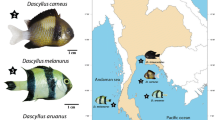Abstract
To investigate the recent transposition activity of T2 family miniature inverted-repeat transposable elements (MITEs) in Xenopus tropicalis (Western clawed frog), we analyzed the intraspecific polymorphisms associated with MITE insertion in X. tropicalis for three subfamilies of the T2 family (T2-A1, T2-C, and T2-E). A high frequency of MITE-insertion polymorphisms was observed at the T2-A1 (50%) and T2-C insertion loci (60%), but none were noted at the T2-E insertion locus (0%). Analyses of the collected data indicated that members of the T2-A1 and T2-C subfamilies may be currently active in the host species. Identification of these active transpositions will help us in understanding the mechanisms underlying the long-term survival (over several tens of millions of years) of the T2-A1 and T2-C subfamilies.



Similar content being viewed by others
References
Bergero R, Forrest A, Charlesworth D (2008) Active miniature transposons from a plant genome and its non-recombining Y chromosome. Genetics 178:1085–1092
Brookfield J (2005) The ecology of the genome—mobile DNA elements and their hosts. Nat Rev Genet 6:128–136
Chen Y, Zhou F, Li G, Xu Y (2008) A recently active MITE, Chunjie, inserted into an operon without disturbing the operon structure in Geobacter uraniireducens Rf4. Genetics 179:2291–2297
Evans BJ, Kelley DB, Tinsley RC, Melnick DJ, Cannatella DC (2004) A mitochondrial DNA phylogeny of African clawed frogs: phylogeography and implications for polyploid evolution. Mol Phylogenet Evol 33:197–213
Feschotte C, Zhang X, Wessler RW (2002) Miniature inverted-repeat transposable elements and their relationships to established DNA transposons. In: Craig NL, Craigie R, Gellert M, Lambowitz AM (eds) Mobile DNA II. ASM Press, Washington, DC, pp 1093–1110
Hellsten U, Harland MH, Gilchrist MJ et al (2010) The genome of the western clawed frog Xenopus tropicalis. Science 328:633–636
Hikosaka A, Kawahara A (2004) Lineage-specific tandem repeats riding on a transposable element of MITE in Xenopus evolution: a new mechanism for creating simple sequence repeats. J Mol Evol 59:738–746
Hikosaka A, Kawahara A (2010) A systematic search and classification of T2 family miniature inverted-repeat transposable elements (MITEs) in Xenopus tropicalis suggests the existence of recently active MITE subfamilies. Mol Genet Genomics 283:49–62
Hikosaka A, Yokouchi E, Kawahara A (2000) Extensive amplification and transposition of a novel repetitive element, Xstir, together with its terminal inverted repeat in the evolution of Xenopus. J Mol Evol 51:554–564
Hikosaka A, Kobayashi T, Saito Y, Kawahara A (2007) Evolution of the Xenopus piggyBac transposon family TxpB: domesticated and untamed strategies of transposon subfamilies. Mol Biol Evol 24:2648–2656
Izsvák Z, Ivics Z, Shimoda N, Mohn D, Okamoto H, Hackett PB (1999) Short inverted-repeat transposable elements in teleost fish and implications for a mechanism of their amplification. J Mol Evol 48:13–21
Jiang N, Bao Z, Zhang X, Hirochika H, Eddy SR, McCouch SR, Wessler SR (2003) An active DNA transposon family in rice. Nature 421:163–167
Jurka J, Kapitonov VV, Pavlicek A, Klonowski P, Kohany O, Walichiewicz J (2005) Repbase Update, a database of eukaryotic repetitive elements. Cytogenet Genome Res 110:462–467
Kapitonov VV, Jurka J (2007) Kolobok, a novel superfamily of eukaryotic DNA transposons. Repbase Rep 7:111
Kashiwagi K, Kashiwagi A, Kurabayashi A, Hanada H, Nakajima K, Okada M, Takase M, Yaoita Y (2010) Xenopus tropicalis: an ideal experimental animal in amphibia. Exp Anim 59:395–405
Kikuchi K, Terauchi K, Wada M, Hirano H (2003) The plant MITE mPing is mobilized in anther culture. Nature 421:167–170
Knöchel W, Korge E, Basner A, Meyerhof W (1986) Globin evolution in the genus Xenopus: comparative analysis of cDNAs coding for adult globin polypeptides of Xenopus borealis and Xenopus tropicalis. J Mol Evol 23:211–223
Koga A, Suzuki M, Inagaki H, Bessho Y, Hori H (1996) Transposable element in fish. Nature 383:30
Koga A, Shimada A, Kuroki T, Hori H, Kusumi J, Kyono-Hamaguchi Y, Hamaguchi S (2007) The Tol1 transposable element of the medaka fish moves in human and mouse cells. J Hum Genet 52:628–635
Nakazaki T, Okumoto Y, Horibata A, Yamahira S, Teraishi M, Nishida H, Inoue H, Tanisaka T (2003) Mobilization of transposon in rice genome. Nature 421:170–172
Rice P, Longden I, Bleasby A (2000) EMBOSS: the European Molecular Biology Open Software Suite. Trends Genet 16:276–277
Ünsal K, Morgan GT (1995) A novel group of families of short interspersed repetitive elements (SINEs) in Xenopus: evidence of a specific target site for DNA-mediated transposition of inverted-repeat SINEs. J Mol Biol 248:812–823
Zhou F, Tran T, Xu Y (2008) Nezha, a novel active miniature inverted-repeat transposable element in cyanobacteria. Biochem Biophys Res Commun 365:790–794
Acknowledgments
We wish to express our gratitude to the National Bioresource Project, particularly to Dr. Yaoita and Dr. Kashiwagi (Center for Amphibian Biology, Hiroshima University) and Dr. Asashima and Dr. Takahashi (Graduate School of Arts and Sciences, The University of Tokyo) for providing X. tropicalis strains. We thank the United States Department of Energy Joint Genome Institute (DOE JGI) for providing X. tropicalis genome data. This work was supported by a Grant-in-Aid for Scientific Research from the Ministry of Education, Culture, Sports, Science, and Technology (Grant number 19651083 and 22570212).
Author information
Authors and Affiliations
Corresponding author
Additional information
Communicated by S. Hohmann.
Rights and permissions
About this article
Cite this article
Hikosaka, A., Nishimura, K., Hikosaka-Katayama, T. et al. Recent transposition activity of Xenopus T2 family miniature inverted-repeat transposable elements. Mol Genet Genomics 285, 219–224 (2011). https://doi.org/10.1007/s00438-010-0599-3
Received:
Accepted:
Published:
Issue Date:
DOI: https://doi.org/10.1007/s00438-010-0599-3




